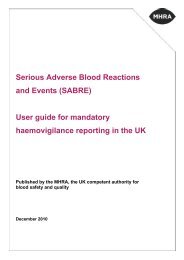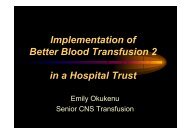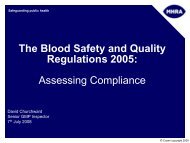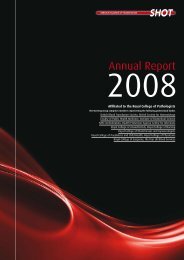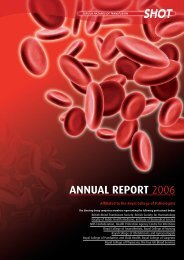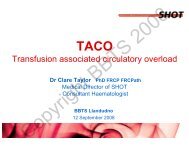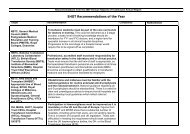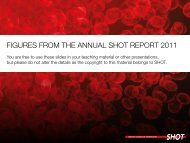Dianne Kitchen TEG rotem qc
Dianne Kitchen TEG rotem qc
Dianne Kitchen TEG rotem qc
You also want an ePaper? Increase the reach of your titles
YUMPU automatically turns print PDFs into web optimized ePapers that Google loves.
Thrombelastography (<strong>TEG</strong>) and<br />
Rotational Thromboelastometry (ROTEM):<br />
UK NEQAS for Blood Coagulation pilot scheme<br />
<strong>Dianne</strong> <strong>Kitchen</strong><br />
Specialist scientific lead for POC programmes<br />
UK NEQAS ( Blood Coagulation), Sheffield, UK
N ational<br />
E xternal<br />
Q uality<br />
A ssessment<br />
S cheme<br />
Not for profit organisation<br />
Part of NHS<br />
Role is to improve quality of testing and<br />
ultimately patient care
quality control<br />
the process of looking at goods when they are<br />
being produced to make certain that all the<br />
goods are of the intended standard<br />
In a medical situation<br />
To ensure all results are valid and accurate (and<br />
to be able to prove that the correct procedures<br />
were in place)
Internal QC<br />
Purchased from manufacturer<br />
Compares your result to a pre<br />
determined range<br />
On-going process<br />
Are my results the same<br />
today as they were yesterday<br />
Precision/ Reproducibility<br />
External QA<br />
A service from an external<br />
organisation<br />
Compares your result with<br />
other users<br />
Spot check<br />
Are my results the same as<br />
other centres doing the same<br />
test<br />
Accuracy
If the True result is<br />
the bull's-eye, this<br />
group of tests is<br />
inaccurate and<br />
imprecise
If the True result is<br />
the bull's-eye, this<br />
group of tests is<br />
inaccurate but<br />
precise
If the True is the<br />
bull's-eye, this group<br />
of tests is both<br />
accurate and precise
Tests of global haemostasis<br />
Often used in a POC setting such as theatres<br />
Allow reduction in turnaround time of tests<br />
Often used by non laboratory staff<br />
Quality control not always performed
®<br />
Cup rotates pin is<br />
stationary<br />
Cup are either Plain cup<br />
or Heparinase cup
®<br />
Pin rotates Cup is stationary<br />
Many reagents available,<br />
INTEM, EXTEM and<br />
HEPTEM
Time for clotting to<br />
begin<br />
Time until clot is 20 mm<br />
Rate of clot growth<br />
Clot firmness - trace<br />
width<br />
ROTEM<br />
CT (sec)<br />
CFT (sec)<br />
Angle( degrees)<br />
MCF (mm)<br />
<strong>TEG</strong><br />
R (min)<br />
K (min)<br />
Angle (degrees)<br />
MA (mm)
ROTEM / <strong>TEG</strong> analysis<br />
Angle<br />
time<br />
60 mm<br />
20 mm<br />
maximum clot<br />
firmness<br />
(MCF / MA) [mm]<br />
clotting time (CT / R)<br />
clot formation time (CFT / K)
Introduced in April 2006 as a pilot study<br />
Performed 8 surveys with 2 sample per survey<br />
Samples are lyophilised plasma, provided with<br />
diluent and pipette to reconstitute<br />
Parameters to test are<br />
For <strong>TEG</strong><br />
R, K, Angle and MA at 30 minutes<br />
For Rotem- CT, CFT, Angle, A10, A20 and MCF at<br />
30 minutes
Plain cup n=40<br />
Heparinase cup n=40<br />
Median<br />
CV%<br />
Range<br />
Median<br />
CV%<br />
Range<br />
R (mins)<br />
6.3<br />
26.7<br />
5.2-14.1<br />
6.7<br />
25.7<br />
5.3-13.0<br />
Angle<br />
76.2<br />
8.8<br />
54.8-79.8<br />
74.8<br />
10.0<br />
43.2-80.7<br />
K (mins)<br />
0.9<br />
51.9<br />
0.8-3.8<br />
1.0<br />
47.1<br />
0.8-3.6<br />
MA<br />
(mm at 30<br />
mins)<br />
44.6<br />
10.6<br />
39.6-69.0<br />
43.7<br />
6.8<br />
37.6-49.6<br />
This was a normal pooled sample<br />
Interpretations of R time for this sample were 25/33 normal for<br />
Plain cup and 22/31 were normal for heparinase cup
INTEM n=16<br />
EXTEM n=16<br />
Median<br />
CV%<br />
Range<br />
Median<br />
CV%<br />
Range<br />
CT (secs)<br />
149<br />
12.6%<br />
135-196<br />
43.5<br />
131.4%<br />
35-417<br />
Angle<br />
84.5<br />
1.2%<br />
81-85<br />
85<br />
7.0%<br />
62-87<br />
CFT (secs)<br />
28<br />
16.4%<br />
24-43<br />
26<br />
91.4%<br />
19-147<br />
A10 (mm)<br />
35.5<br />
8.0%<br />
30-41<br />
37<br />
7.2%<br />
34-43<br />
A20 (mm)<br />
MCF (mm at<br />
30 mins)<br />
38.3<br />
38.5<br />
6.9%<br />
9.4%<br />
34-43<br />
30-46<br />
This was a normal pooled sample<br />
39.5<br />
41<br />
7.5%<br />
8.2%<br />
Interpretations of CT for this sample were 12/14 normal for<br />
INTEM and 10/11 for EXTEM normal<br />
37-47<br />
38-50
INTEM n=16<br />
EXTEM n=16<br />
Result<br />
Median<br />
Result<br />
Median<br />
CT (secs)<br />
182<br />
149<br />
417<br />
43.5<br />
Angle<br />
81<br />
84.5<br />
62<br />
85<br />
CFT (secs)<br />
43<br />
28<br />
147<br />
26<br />
A10 (mm)<br />
30<br />
35.5<br />
34<br />
37<br />
A20 (mm)<br />
38<br />
38.3<br />
37<br />
39.5<br />
MCF (mm at 30<br />
mins)<br />
30<br />
38.5<br />
38<br />
41<br />
EXTEM results showed some major deviations from to median value<br />
Upon contact reagents for this test were found to be out of date
Plain cup n=35<br />
Heparinase cup n=35<br />
Median<br />
CV%<br />
Range<br />
Median<br />
CV%<br />
Range<br />
R (mins)<br />
18.0<br />
22.8<br />
12.7-25.2<br />
MA (mm at<br />
30 mins)<br />
No clotting achieved<br />
40.8<br />
51.3<br />
3.7-56.5<br />
This was a sample with added heparin to mimic a heparinised patient<br />
Interpretations of R time for this sample were 31/31 abnormal for Plain<br />
cup and 24/24 were abnormal for heparinase cup
INTEM n=15<br />
HEPTEM n=13<br />
Median<br />
CV%<br />
Range<br />
Median<br />
CV%<br />
Range<br />
CT (secs)<br />
MCF (mm at<br />
30 mins)<br />
No clotting achieved<br />
354<br />
60<br />
19.0<br />
3.8<br />
281-<br />
516<br />
56-64<br />
This was a sample with added heparin to mimic a heparinised patient<br />
Interpretations of CT for this sample were 15/15 abnormal for INTEM and<br />
6/7 were abnormal for HEPTEM
Quality control is essential for any test whether<br />
laboratory based or POC.<br />
Participation in an EQA programme can help to<br />
ensure reliable results<br />
EQA performance will give reassurance that the<br />
tests are giving similar results to other users
www.ukneqasbc.org<br />
dianne.kitchen@coageqa.org.uk



